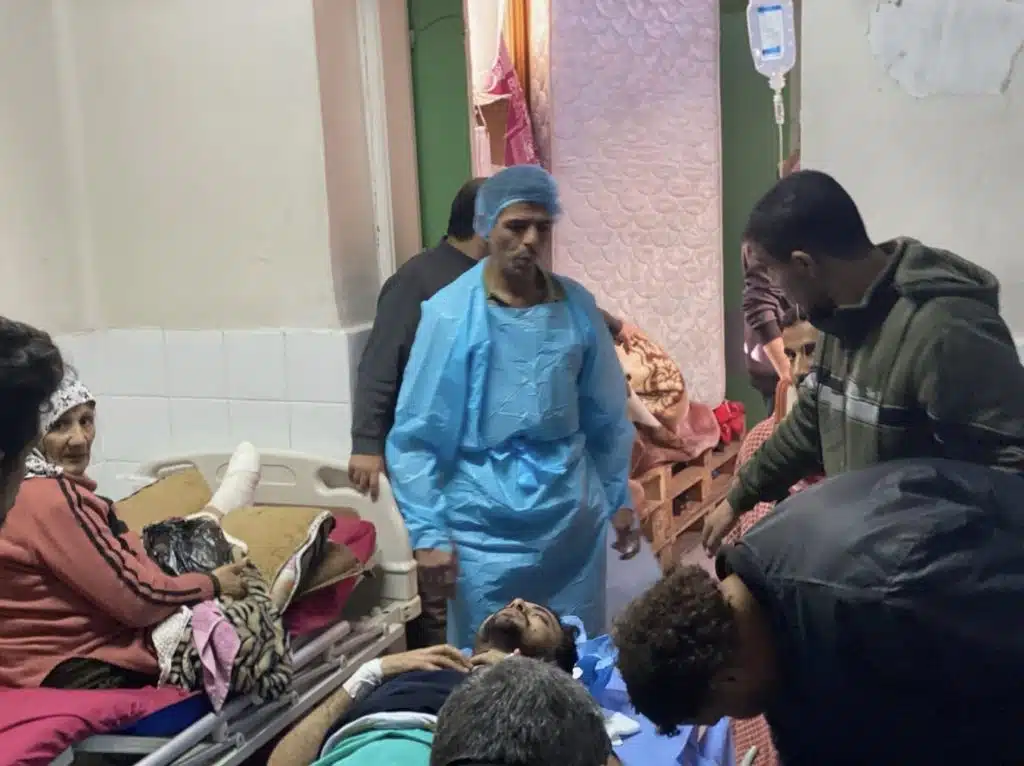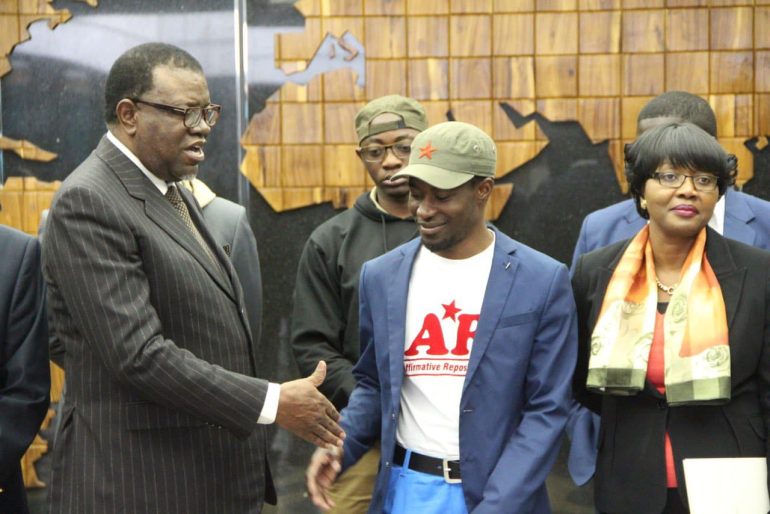Omanyano ovanhu koikundaneki yomalungula kashili paveta, Commisiner Sakaria takunghilile
Veronika Haulenga
Omanyano ovanhu koikundaneki yomalungula kashili paveta, Commisiner Sakaria takunghilile
Veronika Haulenga
Listeners:
Top listeners:
-
play_arrow
Omanyano ovanhu koikundaneki yomalungula kashili paveta, Commisiner Sakaria takunghilile Veronika Haulenga
The Narrow Aid Pipeline to Gaza Could Shrink Further If Israel Gets Its Way



By Fatma Katr via PassBlue
Israel’s plan to intensify its ground operations in Gaza’s south includes seizing control of the Philadelphi Corridor, a stretch of land adjacent to the Egypt-Gaza border. But the plan risks breaching Egyptian sovereignty and disrupting the already abysmal flow of humanitarian aid into Gaza. The Israeli government contends that controlling the Corridor is crucial to its goal of eradicating Hamas and cutting off the smuggling of weapons to its fighters.
“We’ll destroy Hamas, we’ll demilitarize Gaza, and military equipment and other deadly weapons will continue to enter this southern opening — so of course we need to close it,” Prime Minister Benjamin Netanyahu said during a press briefing on Jan. 13.
Members of Gaza’s aid community fear that the humanitarian crisis in the enclave, which is under siege by Israel, will worsen if it seizes the Corridor, a 14-kilometer strip of land that acts as a buffer zone between Gaza and Egypt.
Lifesaving goods are currently being trucked into Gaza through the Rafah and the Kerem Shalom crossing gates, which are both located along the Philadelphi Corridor, also called the Salah al-Din Corridor. It has been patrolled by Egyptian security forces since Israel pulled out of Gaza in 2005, and its status was guaranteed by the 1979 Egypt-Israel peace treaty.
The Corridor is 100 meters wide, and starts south of Kerem Shalom and ends at the Mediterranean coast. It is considered the last stop in southern Gaza and divides the city of Rafah into two; an Egyptian side and a Palestinian side.
The Israel-Hamas war broke out on Oct. 7, after Hamas’s attacks killed some 1,200 people, mostly Israelis, while 136 others remain hostages. The ensuing invasion by Israel in Gaza has displaced 1.9 million Palestinians, or 85 percent of the population, and Israeli ground and air attacks have killed at least 24,285 Palestinians and injured approximately 61,000 others as of Jan. 16, according to the Gaza Health Ministry.
The war has turned the Gaza Strip into an ““uninhabitable” territory in the last three months, with a deadly humanitarian crisis underway, UN relief chief Martin Griffiths says repeatedly.
 The current crossings being used to deliver aid into Gaza are Rafah and Kerem Shalom. The Philadelphi Corridor encompasses the crossings, and Egypt has repeatedly rejected proposals regarding the sovereignty of the Corridor. SOURCE: UNOCHA
The current crossings being used to deliver aid into Gaza are Rafah and Kerem Shalom. The Philadelphi Corridor encompasses the crossings, and Egypt has repeatedly rejected proposals regarding the sovereignty of the Corridor. SOURCE: UNOCHA
Philadelphi Corridor’s strategic value
Israel wants to turn the Philadelphi Corridor into a base for the next phase in the war in the south to eradicate Hamas, regardless of how intensifying military operations could further impede aid flow into the area. The World Food Program executive director, Cindy McCain, said this week that the agency could keep famine at bay only if enough aid can be delivered safely to everyone in need, “wherever they are.” UN aid officials said in a joint statement that new entry routes needed to be opened immediately to stave off a more fatal crisis.
But Israel contends that there are tunnels under the Gaza-Egypt border region that Hamas uses to smuggle weapons into the enclave. Egypt, however, counters that it destroyed such tunnels years ago. The tunnel network served as a way to transfer food, gas and consumer goods into Gaza because the aboveground trade route was closed due to the decades-long blockade enforced by Israel and supported by Egypt.
Once Hamas began governing Gaza, it controlled the commercial activities carried out through the tunnels by establishing the Tunnel Affairs Commission, a unit affiliated with the Gaza Interior Ministry, to formalize the “smuggling economy through regulation,” according to the Institute for Palestinian Studies.
Israeli defense officials estimate there are 350 to 450 miles of tunnels under Gaza, according to a recent report in The New York Times. The scope, depth and quality of the tunnel construction reportedly surprised Israeli officials, reflecting intelligence failures of the Israeli military in underestimating the extent of the network.
In 2014, Hamas militants used the tunnels along Gaza’s border with Israel as well as others near Rafah to attack Israeli troops, The Guardian reported that year. The IDF’s southern command chief, Maj. Gen. Sami Turgeman, said then that Israel was “just a few days away from destroying all of the offensive tunnels.”
In 2005, Israel signed the Philadelphi Accord with Egypt, known as the Arrangements Regarding the Deployment of a Designated Force of Border Guards. It transferred control of the corridor to Egypt, which deployed 750 soldiers on its side of the border in Rafah. They have monitored the territory, prevented border infiltration and conducted counterterrorism activities, according to officials.
Israeli authorities recently spoke with the Egyptian government about its military operation along the Gazan side of the border and proposed removing Palestinian officials at the Rafah crossing to position Israeli troops along the Corridor instead.
An Egyptian official told the Arab World Press this month that the 1979 treaty, as it pertains to protecting Egypt’s sovereignty, bans Israel from conducting military operations along the Philadelphi route and denied that the Corridor is being used for smuggling weapons into Gaza. Egypt has repeatedly rejected any proposals regarding the Corridor, and any Israeli offensive there depends on negotiations with Egypt.
An unnamed Egyptian official told Sky News Arabia on Jan. 13 that Egypt was not coordinating plans with Israel regarding the Corridor and warned Israel and the United States against conducting military operations along the route.
“Egypt continues to have full control over its borders, and these issues are subject to legal and security agreements between countries involved, so any discussions over the [Corridor] is thoroughly examined and is publicly responded to with declared positions,” Egyptian Foreign Ministry Spokesperson Ahmed Abu Zeid told Egyptian TV channel Sada Al-Balad recently.
Egypt informed Israel that it was strengthening its security on its side of the border by installing more observation towers, surveillance cameras and physical barriers, Egyptian officials recently said to the Wall Journal Street Journal.
Israeli control could end aid delivery
As the war just hit the 100-days mark, Gaza’s population is growing more plagued with disease, illnesses and hunger, while winter conditions have made life even more miserable as fuel and water remain scarce.
Hani Almadhoun, the director of philanthropy at Unrwa USA (UN Relief and Works Agency), told PassBlue that if Israel fully controlled the Philadelphi Corridor, it would be taking over the entirety of Gaza, including foot traffic and aid deliveries.
“This would conflict with Israel’s previous statements that they want to disengage from Gaza 100 percent,” Almadhoun said in a phone interview. “They have already controlled the north and now they want to control the south, so that would turn Gaza into a prison.”
The Rafah crossing remains the single pedestrian path for both evacuations and aid delivery to and from the enclave since Oct. 7, when the Erez Crossing, a land crossing in north Gaza, closed after it was heavily damaged in the war. Almadhoun also told PassBlue that the Kerem Shalom gate, in the far south, near Rafah and on the border of Israel, was formerly used only to get humanitarian and commercial supplies in on a normal day, before Oct. 7.
The Israeli-controlled Kerem Shalom gate, which reopened in December, is still a cumbersome route. It allowed around 100 aid trucks to cross daily between Jan. 10 and 11, according to the Coordination of Government Activities in the Territories (Cogat), a unit that is part of the Israeli defense ministry.
On a typical day before the war, 500 aid and commercial trucks entered Gaza through Rafah, but now far fewer trucks enter on most days. At the Rafah and Kerem Shalom gates, only 204 aid convoys entered Rafah and Kerem Shalom gates, from Jan. 15-16, according to the UN.
UN officials repeatedly say that not nearly enough aid is flowing in, despite numerous Security Council resolutions pushing for basic supplies to reach Gazan civilians. Wael Abu Omar, the Palestinian Rafah Crossing Authority spokesperson, told PassBlue that some aid trucks are delayed into Gaza or diverted by inspections from Israeli forces.
Israel continues to blame the UN for problems with aid reaching Gaza. Col. Moshe Tetro, a Cogat official, said that the UN needs to send more aid workers to pack and receive supplies. Colonel Tetro recently denied that Gazans were suffering from hunger, saying that “the reserves in Gaza are sufficient for the near term.”
A World Food Program spokesperson, who asked to be unnamed, told PassBlue that it was difficult for the agency to reach people because of the active bombardments.Trucks crossing into Gaza face not only military sniping but also “logistical bottlenecks,” which include limited verification and transport capacity inside Gaza.
It remains unclear how the passage of aid would be affected if Israel seizes the Philadelphi Corridor, the World Food Program spokesperson told Pass Blue.
Sigrid Kaag, a former Dutch politician, began her work on Jan. 8 as UN senior humanitarian and reconstruction coordinator for Gaza, as mandated by the Security Council. Her role to expedite aid flow into the enclave under war conditions will be watched closely, even if she has the seeming cooperation of regional players.
 The World Health Organization and partners delivering much-needed fuel to hospitals in north Gaza, Nov. 29, 2023. WHO/OPT
The World Health Organization and partners delivering much-needed fuel to hospitals in north Gaza, Nov. 29, 2023. WHO/OPT
Aid delivery hassles
Countries that want to provide humanitarian relief to Gaza must fly it to El Arish airport in Sinai, Egypt. The aid is then loaded onto trucks and driven for nearly two hours to the Rafah crossing on Egypt’s side and an additional two hours to Nitzana village in Israel’s western Negev desert, where Israeli forces do inspections.
There is a list of forbidden “dual-use” items that Israel refuses to share, according to Unrwa, and these goods can’t be loaded onto trucks. If any of the items is found in a convoy, the truck must return to Egypt’s Rafah crossing and remove them. Items that Israel has rejected include tent poles, batteries, solar panels and incubators, according to an explainer that Unrwa shared with PassBlue.
The trucks return to Nitzana after the banned items are removed for reinspection. Israeli forces then escort the truck to Rafah, where it joins a long line to get into Gaza. Yet Israel can still prevent the trucks from entering, according to Unrwa.
Injured Palestinians also use the Rafah crossing to seek medical treatment in hospitals in Arish, in Egypt. However, Bashar Murad, the director-general of the Palestinian Red Crescent in Gaza, told PassBlue that only 15 Palestinians are allowed to cross for medical treatment daily.
“Israel decides who travels for treatment through the Rafah land crossing, and no patient is allowed to travel without approval from Israel,” Murad said. “Palestinians lost the most basic human rights: the right to treatment, the right to travel, and the right to education.”
Rafah’s refugee influx
Israel’s plan to conduct a ground operation along the border has raised global concerns about the already enormous number of Palestinians who have been forcibly displaced to south Gaza.
Rafah City Mayor Ahmed Al-Sufi told Egyptian state-owned Al-Ahram Weekly that over one million displaced Palestinians live in the streets of Rafah, with almost no space left for sheltering in schools or Unrwa facilities.
“The severe crowding, with displaced persons’ tents lining the roads and pavements, has rendered movement nearly impossible,” Al-Sufi said..
The Israel Defense Forces have not said how they would avoid killing Palestinian civilians along the Rafah border in their goal to wipe out Hamas and the militant group’s tunnels, but the Times of Israel cited Israeli officials who said that the army would avoid the massive air and ground operations that were conducted in the north.
Yet Ilze Brands Kehris, a top UN human rights official, recently described to the Security Council the nature of Israeli military operations overall, saying: “While Israel stated that its evacuation orders have been for the safety of Palestinian civilians, it appears that Israel has made scant provision to ensure such relocations comply with international law — in particular ensuring access to appropriate hygiene, health, safety, nutrition and shelter and taking steps to minimise the risk of separation of family members.
Such compelled evacuations, failing to meet the necessary conditions for lawfulness, therefore potentially amount to forcible transfer, a war crime.”
To read the original article click here.
Written by: Contributed
aid Gaza Hamas IDF Israel Palestine
Similar posts
Windhoek Weather
Most popular

Mbumba signs off new benefits for retired political office bearers

Former FNB employee arrested after defraud pensioner off N$215, 000

Namdia Heist: More questions, lots of confusion

Omuhwahwameki Michael okuunganeka oshikonga shoku patitha oostola dho Rani moshilongo ashihe.

Windhoek woman loses N$60,000 to fraudsters
Copyright 2025 Future Media (Pty) Ltd | Website by Digital Platforms
Tel: +264 83 000 1000 | Email: news@futuremedia.com.na





